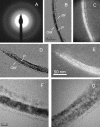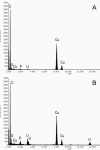Importance of c-Type cytochromes for U(VI) reduction by Geobacter sulfurreducens
- PMID: 17346345
- PMCID: PMC1829397
- DOI: 10.1186/1471-2180-7-16
Importance of c-Type cytochromes for U(VI) reduction by Geobacter sulfurreducens
Abstract
Background: In order to study the mechanism of U(VI) reduction, the effect of deleting c-type cytochrome genes on the capacity of Geobacter sulfurreducens to reduce U(VI) with acetate serving as the electron donor was investigated.
Results: The ability of several c-type cytochrome deficient mutants to reduce U(VI) was lower than that of the wild type strain. Elimination of two confirmed outer membrane cytochromes and two putative outer membrane cytochromes significantly decreased (ca. 50-60%) the ability of G. sulfurreducens to reduce U(VI). Involvement in U(VI) reduction did not appear to be a general property of outer membrane cytochromes, as elimination of two other confirmed outer membrane cytochromes, OmcB and OmcC, had very little impact on U(VI) reduction. Among the periplasmic cytochromes, only MacA, proposed to transfer electrons from the inner membrane to the periplasm, appeared to play a significant role in U(VI) reduction. A subpopulation of both wild type and U(VI) reduction-impaired cells, 24-30%, accumulated amorphous uranium in the periplasm. Comparison of uranium-accumulating cells demonstrated a similar amount of periplasmic uranium accumulation in U(VI) reduction-impaired and wild type G. sulfurreducens. Assessment of the ability of the various suspensions to reduce Fe(III) revealed no correlation between the impact of cytochrome deletion on U(VI) reduction and reduction of Fe(III) hydroxide and chelated Fe(III).
Conclusion: This study indicates that c-type cytochromes are involved in U(VI) reduction by Geobacter sulfurreducens. The data provide new evidence for extracellular uranium reduction by G. sulfurreducens but do not rule out the possibility of periplasmic uranium reduction. Occurrence of U(VI) reduction at the cell surface is supported by the significant impact of elimination of outer membrane cytochromes on U(VI) reduction and the lack of correlation between periplasmic uranium accumulation and the capacity for uranium reduction. Periplasmic uranium accumulation may reflect the ability of uranium to penetrate the outer membrane rather than the occurrence of enzymatic U(VI) reduction. Elimination of cytochromes rarely had a similar impact on both Fe(III) and U(VI) reduction, suggesting that there are differences in the routes of electron transfer to U(VI) and Fe(III). Further studies are required to clarify the pathways leading to U(VI) reduction in G. sulfurreducens.
Figures








Similar articles
-
Toward establishing minimum requirements for extracellular electron transfer in Geobacter sulfurreducens.FEMS Microbiol Lett. 2017 May 1;364(9). doi: 10.1093/femsle/fnx093. FEMS Microbiol Lett. 2017. PMID: 28472266
-
U(VI) reduction by diverse outer surface c-type cytochromes of Geobacter sulfurreducens.Appl Environ Microbiol. 2013 Oct;79(20):6369-74. doi: 10.1128/AEM.02551-13. Epub 2013 Aug 9. Appl Environ Microbiol. 2013. PMID: 23934497 Free PMC article.
-
Identification of Different Putative Outer Membrane Electron Conduits Necessary for Fe(III) Citrate, Fe(III) Oxide, Mn(IV) Oxide, or Electrode Reduction by Geobacter sulfurreducens.J Bacteriol. 2018 Sep 10;200(19):e00347-18. doi: 10.1128/JB.00347-18. Print 2018 Oct 1. J Bacteriol. 2018. PMID: 30038047 Free PMC article.
-
Dissimilatory Fe(III) and Mn(IV) reduction.Adv Microb Physiol. 2004;49:219-86. doi: 10.1016/S0065-2911(04)49005-5. Adv Microb Physiol. 2004. PMID: 15518832 Review.
-
Respiration of metal (hydr)oxides by Shewanella and Geobacter: a key role for multihaem c-type cytochromes.Mol Microbiol. 2007 Jul;65(1):12-20. doi: 10.1111/j.1365-2958.2007.05783.x. Mol Microbiol. 2007. PMID: 17581116 Free PMC article. Review.
Cited by
-
Abundance of the multiheme c-type cytochrome OmcB increases in outer biofilm layers of electrode-grown Geobacter sulfurreducens.PLoS One. 2014 Aug 4;9(8):e104336. doi: 10.1371/journal.pone.0104336. eCollection 2014. PLoS One. 2014. PMID: 25090411 Free PMC article.
-
Adaptive Synthesis of a Rough Lipopolysaccharide in Geobacter sulfurreducens for Metal Reduction and Detoxification.Appl Environ Microbiol. 2021 Sep 28;87(20):e0096421. doi: 10.1128/AEM.00964-21. Epub 2021 Aug 4. Appl Environ Microbiol. 2021. PMID: 34347518 Free PMC article.
-
A survey of the Desulfuromonadia "cytochromome" provides a glimpse of the unexplored diversity of multiheme cytochromes in nature.BMC Genomics. 2024 Oct 20;25(1):982. doi: 10.1186/s12864-024-10872-4. BMC Genomics. 2024. PMID: 39428470 Free PMC article.
-
The shifts of sediment microbial community phylogenetic and functional structures during chromium (VI) reduction.Ecotoxicology. 2016 Dec;25(10):1759-1770. doi: 10.1007/s10646-016-1719-6. Epub 2016 Sep 16. Ecotoxicology. 2016. PMID: 27637513
-
Dynamic Succession of Groundwater Functional Microbial Communities in Response to Emulsified Vegetable Oil Amendment during Sustained In Situ U(VI) Reduction.Appl Environ Microbiol. 2015 Jun 15;81(12):4164-72. doi: 10.1128/AEM.00043-15. Epub 2015 Apr 10. Appl Environ Microbiol. 2015. PMID: 25862231 Free PMC article.
References
-
- Ewing RC. Radioactivity and the 20th century. In: FR Burns PC, editor. Uranium: Mineralogy, Geochemistry and the Environment. Vol. 38. Mineralogical Society of America, Washington, DC; 1999. pp. 1–21.
-
- Lieser KH. Radionuclides in the geosphere: sources, mobility, reactions in natural waters and interactions with solids. Radiochimica Acta. 1995;70/71:355–375.
-
- Suzuki Y, Banfield JF. Geomicrobiology of uranium. In: FR Burns PC, editor. Uranium: Mineralogy, Geochemistry and the Environment. Vol. 38. Mineralogical Society of America, Washington, DC; 1999. pp. 393–432.
-
- DiChristina TJ, Fredrickson JK, Zachara JM. Enzymology of electron transport: energy generation with geochemical consequences. In: JF Banfield, Cervini-Silva J, Nealson KH, editor. Molecular Geomicrobiology. Mineralogical Society of America; 2005. pp. 27–52.
-
- Lovley DR, Phillips EJP, Gorby YA, Landa ER. Microbial reduction of uranium. Nature. 1991;350:413–416. doi: 10.1038/350413a0. - DOI
Publication types
MeSH terms
Substances
LinkOut - more resources
Full Text Sources
Molecular Biology Databases

